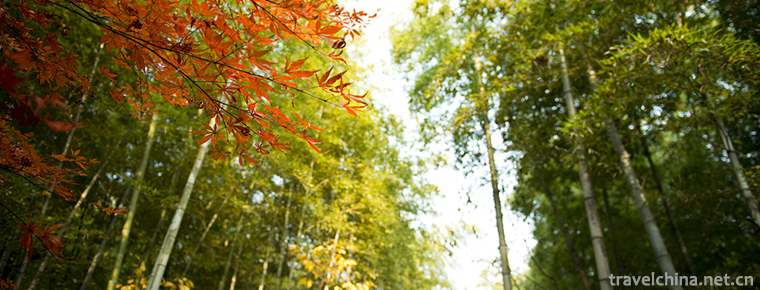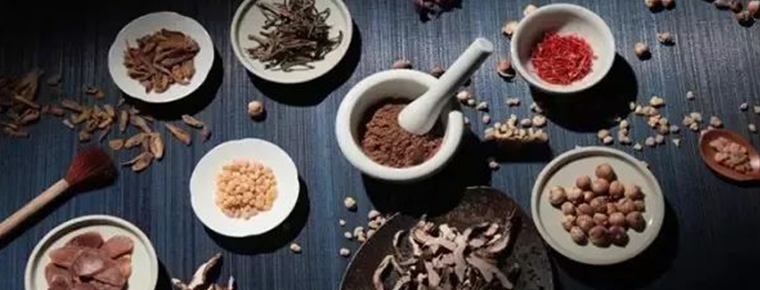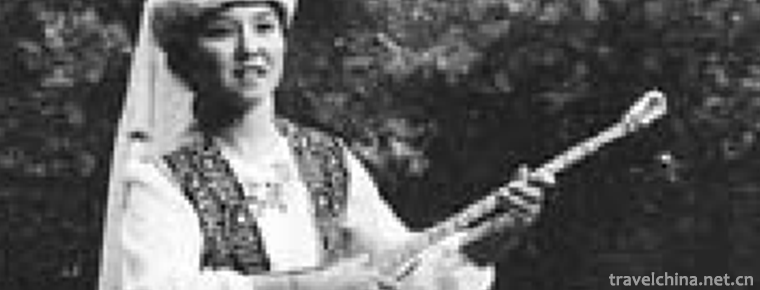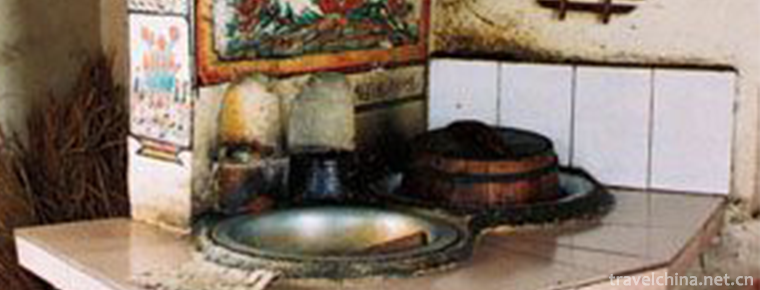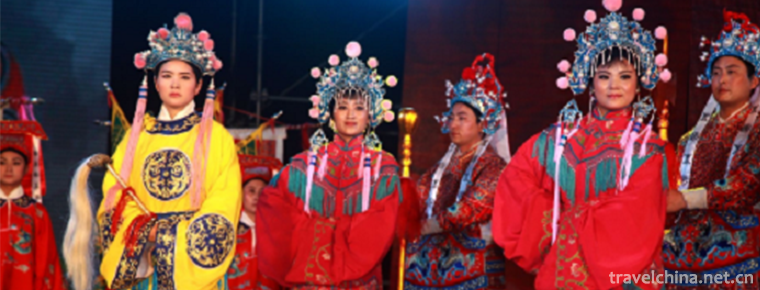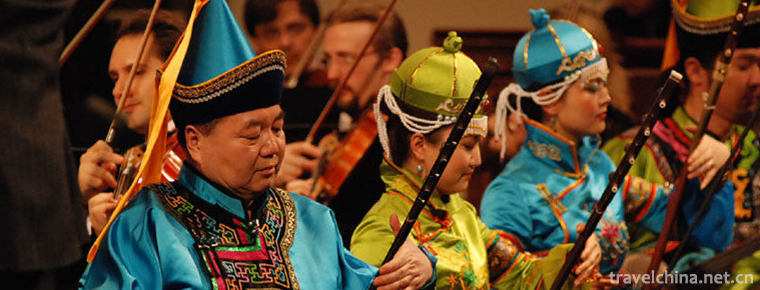Guangegou National Forest Park
Guangegou National Forest Park
Guan'e Gou National Forest Park, located in the outskirts of Chang County, Longnan City, Gansu Province, consists of Guanzhugou, Goose Lou Gou, Mulong Gou, Miaogou and other scenic spots, with a total area of 42,000 hectares. It was established as National Forest Park in 2003, AAAA-level tourist attraction in 2007 and National Geopark in 2014.
Guangegou National Forest Park integrates forest landscape, grassland landscape, landform landscape, water landscape, celestial landscape and other natural and human landscape. Lakes such as pearls, canyons such as lines, waterfalls such as weaving, animal and plant distribution is diverse, the ecological environment is beautiful, and the natural landscape is unique. In addition, there are more than 3000 Tibetans and Qiang nationalities living in the park, which retains unique clothing and customs, and is also a good theme for folk tours.
Development history
Ming Shenzong was called Guan'e Gou "Guan'e" in Wanli years, and lived in Ma Tusi's Mafan people. "Guan evil" is a Qiang language, which is translated into "canyon" in Chinese.
In January 1950, when the township government was established, the word "Guan evil" was changed into an official goose because of its derogatory meaning.
In 1999, Daheba Provincial Forest Park was established with the approval of Gansu Forestry Department.
In October 2003, it was promoted to Guan'e Gou National Forest Park.
In 2007, it was awarded National AAAA Tourist Scenic Spot.
In January 2014, it was listed as the seventh batch of national geological parks.
In December 2014, it was listed as one of the 20 key scenic spots in Gansu Province.
In January 2015, the ticket of Guan'e Gou National Forest Park was increased, and the previous 40 yuan per person per person per time was adjusted to 55 yuan per person per time.
In March 2017, the Guan'e Gou Grand Scenic Area Management Committee was established.
geographical environment
position
Guan'e Gou National Forest Park is located one kilometre southwest of Longnan City, Gansu Province. It is 36 kilometres from Hadapu Railway Station, 116 kilometres from Longnan City, 340 kilometres from Lanzhou City, capital of Gansu Province, 670 kilometres from Chongqing City, directly under the Central Government, 540 kilometres from Chengdu City, capital of Sichuan Province, and 650 kilometres from Xi'an City, capital of Shaanxi Province. The park is adjacent to Hadapu Town, a famous revolutionary historical and cultural town in China, and links up Jiuzhaigou, a world cultural heritage.
topographic features
Guan'e Gou National Forest Park is located in the eastern edge of the Qinghai-Tibet Plateau and the intersection of Qinling Mountains and Minshan Mountains. The lowest elevation is 1780 meters and the highest elevation is 4153 meters. The mountains on both sides of the valley are northeast-southwest and high in southwest and low in northeast. There are oil flow sedimentary rocks with complete sedimentary sequence, unique folds and faults, Minshan-type karst, typical landslides, debris flows, collapses and other external dynamic geological relics.
climate
The average annual precipitation in Guangegou is 638.8 mm, which belongs to the semi-humid area. The average annual sunshine is 2095 hours, and the average annual wind speed is 3 meters per second.
natural resources
Biological resources
Guangegou National Forest Park is inhabited by four kinds of state-level protected animals, including white-lipped deer, leopard, clouded leopard and zebra-tailed hazelnut chicken. There are 23 kinds of state-level protected animals, including fur-crowned deer, Sumen antelope, black bear, blue pheasant, brown pheasant, musk deer and red-bellied pheasant. Leopard cat, Northern Mountain Brook salamander, yellow muntjac, stone marten and other seven provincial key protected animals.
There are spruce, yew spruce, fir in Qinling Mountains, Pinus tabulaeformis, Larix Populus, Pinus armandii, Birch, Quercus, Birch, Poplar and other trees and peony, Acer quinquefolium, Paeonia lactiflora, Wild Clove, Populus, Yumei, Malan flower, Rhododendron and more than 700 families of shrubs, including Acanthopanax senticosus, Cordyceps sinensis, Coptis chinensis, Pinellia ternata, Fritillaria, Asarum, and Rhododendron. There are also edible fungi such as Morchella and wild mushroom.
Landscape resources
The Park integrates primitive forest landscape, grassland landscape, landform landscape, water landscape, astronomical landscape and humanistic landscape. The overall quality of landscape resources is high, the spatial layout characteristics are prominent, the distribution of animals and plants is diverse, the ecological environment is beautiful, the natural landscape is peculiar, the strange pine is widespread, the rocks are instantaneous pottery, the mountains are steep, the valleys and canyons are long, the waterfalls are constant, the white waves are running all the year round. Winning is everywhere. Especially in Guan'e Gou scenic spot, the distribution of scenic spots is prominent. The first 14 kilometers of Guan'e Gou scenic spot are 15 colorful lakes, the last 18 kilometers are dense primitive forests of pine and cypress, and the deepest part is alpine meadow and snow mountain that never melts. There are overlapping mountains and valleys, green mountains and clear waters, strange peaks and rocks, splashing waterfalls, meadow snow mountains, Lake torrents, ancient trees towering in the sky, and many interesting rock structures on the cliffs on both sides of the ditch, which are praised by experts as the most ornamental "geological park".
Daheba Scenic Area (E'er Gou) is a picture scroll, with beautiful mountains and rivers, fragrant birds and flowers, round peaks, winding paths and quiet passages. The large area of primitive forest is a natural oxygen bar, Leigu Mountain at an altitude of 4153 meters, the highest peak of Longnan, the top of which is snow all year round, and the vast forest sea surrounded by clouds and mists below the snow line. It has both the majesty of Huangshan Mountain and the strange danger of Huashan Mountain. During the stay, there are many main scenic spots for tourists, such as Liulin Turtle, Shimen Graben, Butianshi, Turtle Water Play, Jinyu Waterfall, Echo Wall, Racing Horse Beach and Leiguxiong Peak.
"The bonfire is bright between the pine trees in Yuewa, and the wind and sound of the flute and the mountain are full of sound and emotion. Brown clothes and fur rubbing back, spring sentiment lingering heart. This is a good sentence of the poet Yang Caimei's poem "Ancient Wind of West Qiang". The Tibetan compatriots living in Daheba today are the descendants of the ancient Qiang who established the state of Michang in the Wei, Jin, Southern and Northern Dynasties. Their language, clothing and living customs still retain the original ecological characteristics of the ancient Qiang. The ruins of Changguo and Yangma City are well preserved. Tibetan women dressed in national costumes, play tunes, sing Tibetan songs, dance Baima Tibetan dance with national characteristics, Niutou Horse Face Dance and Guozhuang Dance, such as picturesque Tibetan customs, enthusiastic and unrestrained bonfire evening party for park tourism added splendor, so that tourists are happy and forget to return.
Main attractions
Overview of scenic spots
Guangegou has a forest coverage rate of 75.1%. The Park integrates natural and human landscapes such as forest landscape, grassland landscape, landform landscape, water landscape, celestial landscape, etc. The overall quality of landscape resources is high, the spatial layout is prominent, the distribution of animals and plants is diverse, the ecological environment is beautiful, and the natural landscape is peculiar. According to the relevant indicators of "China Forest Park Scenic Resources Quality Grade Assessment", the Guan'e Gou National Forest Park Scenic Resources Quality Grade is one.
The first 14 kilometers are 13 colorful lakes, the last 18 kilometers are dense primitive forests of pine and cypress, 9 precipitous canyons soaring into the clouds, 11 small and large waterfalls falling directly from the top or half-mountain cliffs, more than 60 amazing scenic spots, the deepest of which are alpine meadows and snow-capped mountains all the year round.
Guangegou is beautiful. Thirteen lakes of different sizes and shapes, such as a string of Green Pearls inlaid in the ditch, the lake water is clear and transparent, showing different colors with the lake bottom topography. The ancient trees reflected in the lake lie on the lake bottom like giant dragons. Blue sky, white clouds and ancient trees of green hills are reflected in the lake, making the sky and the earth a whole body with no boundaries.
Guan E Gou Shan Jun. Mountains are scattered, surrounded by green water, ancient trees are poor, the weather is thousands of, beautiful mountain body you pull me to lead, graceful; majestic cliff straight into the clouds, magnificent momentum, magnificent, everywhere are landscape paintings. Guangegou is dangerous. Between lakes and snow mountains, nine steep and deep canyons are amazing. Among the canyons of various shapes, which are hundreds of meters long, hundreds of meters high and only ten meters wide, the river is deafening, the cool wind rushes to the face, the cliffs cover the sun with ancient pine, the waterfalls fall down, and visitors are so scared that the timid are in the extreme sense of despair. Such a natural wonder of wicked and magical work is really rare in China. A poet is glad to write poems: Range Rover is partial to the long sun and the moon, goose ditch is hot in summer and the water is cool. Qifeng Pingcui Tonggu, snow spraying beads diarrhea stone beams. Wanmu prosperous green belt jade, heavy cliff Senjie waterfall first, green shade embracing posture, perlite edge wild flowers fragrance.
Introduction of scenic spots
Lu Ren Miao Beach
Located opposite Luren Village in Guan'e Gou, it is said that the temple where the generals of Ming Taizu often met Chun was located. The grassland is flat, the pine forests are lush and the flowers are brilliant.
Zhang man Dong
Zhangye Cave is located between Huaertan and Tongtianmen. Long, long ago, the crustal movement caused the cliff to sink inward, forming a natural cave. Although this cave seems ordinary, people respect it as Zhangye Cave.
Legend has it that during the Hongwu period of the Daming Dynasty, the Emperor of the Ming Dynasty was named one of the Twelve Dragon Kings. King Zhang Dulong practiced in Guangegou, where he drew water from Zhangyedong. Because the Dragon King was in charge of Si Yu, the local people sacrificed the Dragon King of Zhangdu for years in order to keep the weather in order. And the stone cave where King Zhang Dulong draws water to rest is honorably called Zhang Yedong. Zhang Ye worshipped in Guan'e Gou family, especially in Lijieshan and Hejiabao villages.
Chi Feng Ling
Along Touziquan, a steep mountain appeared before people's eyes. On the rocks of the mountain, there stood a pine tree. The whole mountain was buzzing with birds, and there were nests everywhere between the rocks. Legend has it that the Phoenix Mountain god worshipped by the local people inhabits here, so it is named Qifengling.
At the entrance of Guan'e Gou Piaochang Tea-horse Mutual Market, the two mountains are opposite, the cliffs are steep, the cliffs are vast, there is a tendency of "Tianmen interruption". It is the throat fortress leading to Guan'e Gou. Locals call it "Tianmen". Legend has it that long ago, there was a Qiang named Zhang Du who was very intelligent, read books extensively, and was kind and charitable. He was respected as the leader of the Qiang people. There are thousands of valuable Chinese medicinal herbs in Guan'e Valley, which is also a good place for hunting. However, there is a mountain block, isolated from the world, Qiang people need to climb around the wall to enter the valley, which is often unexpected. So Zhang Du practiced Taoism in a stone cave here. He stood in front of the mountain in despair. He asked the heavens and prayed for the way to the heavens. Every day, he moved the heavens. One day, suddenly, thunder and lightning flashed, the sky was dark, and suddenly heard a tremendous noise. The mountain broke open and formed a natural stone gate. People went to watch, but they saw that Zhang Du had turned into a huge stone standing in the gorge, known as "Asking Heavenly Stone". Zhang Du had been tempered into a fairy, was named one of the Twelve Dragon Kings, guarding the pulse of this place. In memory of him, later generations called the cave "Zhangye Cave" and the gorge "Tongtianmen".
Frog Month
Here is a huge stone shaped like a toad, mouth for more than 10 people gathered together in the cave, mouth open, have the potential to swallow the world. Legend has it that people outside the ditch gather and exchange their belongings. Some become friends. They often talk loudly under the "Pearl Waterfall" and startle a clam in the beach who has practiced for thousands of years. So he hid at the foot of the hill opposite the beach, often eavesdropping on people's conversations. Over time, the toad realized many human senses, and finally fully understood and sat down to become immortals.
Tong Tian Men
Here, the two mountains confront each other. The mountain is like a ladder to the sky. The two mountains are close to form a natural mountain gate. From a distance, the mountain is steep and beautiful.
Legend has it that in the Hongwu period of the Daming Dynasty, there lived the Wood Dragon King in Guangegou. The Wood Dragon King was ambitious and ambitious. He wanted to create a great cause. He found that this place was a magical place, and it was a treasure land of geomantic omen. He occupied this place as king and wanted to dominate the world, so he called it Tongtianmen.
Piggyback yard
Long ago, Guan'e Gou primitive forest was hidden in the sky and abounds in many precious medicinal materials. At the same time, it was also a paradise for wild animals such as bears, leopards, rock sheep, antelopes and pheasants. Local people picked Chinese medicine, hunted animals, and then exchanged for some necessities of life outside, forming a Tea-Horse market, which became a famous mountain goods gathering and distributing place, so it was also called a piggyback farm. It has been used up to now.
Diamond rock
Because it looks like a diamond, the drill is facing the sky. It is said that when Nuwa mended the sky, his hand slipped to this point, but his mind never moved, and he always wanted to drill to mend the sky. So it is called "diamond".
The winding path leads to a secluded quiet place
Between the first parking lot and the second parking lot, mountains from east to West form a canyon, with steep mountains on one side. On the other side, the mountains are gentle, beautiful and pleasant. The rocks in the canyon are rugged, and there are gurgling water. During the period, the plant landscape, geological landscape, meteorological landscape and water landscape in the canyon can be seen as if they had entered the natural wild botanical gardens, such as blue sky, white clouds, birds and flowers. There are poems saying, "Mountain green pine with late green, turbulent rapids between the rocks," a school of heavy ink landscape.
Green Dragon diarrhea beads
In the second parking lot, you can see the general spring pouring down from the cliff and cliff cave on the hillside, the water curtain splashing, such as smoke, a basin-shaped beach under the waterfall, surrounded by rocks and green trees, the air is fresh and incomparable, the environment is beautiful and refreshing.
Legend has it that during the Wanli years of the Zong Dynasty, the Qiang people offended God, the earth had been drought for three years, the grain had not been harvested, the Qiang people's background had left home, and they had been displaced. At this time, the Dragon King in charge of the rain was unbearable, resolutely violated the rules of heaven, and rained privately, provoking the Jade Emperor to press him under the cliff and turn him into a cliff. However, a waterfall erupted from Longkou, like a waterfall drifting in the mountains and green waters all the year round. Bailian.
Panlong Gorge
Panlong Gorge is the first secret door of Guangegou. The word "secret door" is a local dialect, meaning "steep stone gorge". Panlong Gorge gives the impression that it is formed by two rocky mountains facing each other and closing in front of each other. About a hundred meters long, circling twists and turns, people feel like a circling dragon passing by. On both sides of the canyon are Qisensensensen's stone walls, glassy and wet. The walls of the gorge are uneven, concave and convex. When people come to the places where the stone edges are protruding, they will meet accidentally. The River sprinkled with joy into the canyon, flowed out along the narrow wall, swaying eastward and westward, making a loud noise. The narrowest part of the whole Canyon is only two or three meters, and the widest part is only four or five meters. Looking up, the narrow walls on both sides penetrate into the clouds, dividing the blue sky into a long ribbon. When Panlong Gorge is formed, one side of the gorge wall is concave, the other side of the gorge wall is protruding. The two sides of the gorge wall coincide with each other in the meandering and winding direction. It is straight, and the curve is twisting, spiraling forward and extending parallel. It can be inferred from this that a long time ago, here was a complete stone mountain, which was later affected by crustal movement and formed a peculiar Canyon after the fracture. But it seems that there is no trace of "axe chisel" and it is amazing the wonder of nature's creation.
The peak of unique beauty
This peak is proud to stand out alone, one peak is unique and beautiful, the peaks are crowded, clouds and mists are shrouded in cloudy and rainy days, if hidden, there is the charm of immortal mountain in the sea and in the empty yarn. On sunny days, it is steep and elegant, beautiful, not lack of fortitude, like a secluded fairy, cold-eyed watching the vicissitudes of the world, even though the heavens and the earth cycle, and the stars move, he is still thinking and silent. Xie Hui, a poet of the Qing Dynasty, once wrote a poem chanting solo and beautiful peaks: "It's winter, cold and then Zhisong. Jackie Chan does not associate with other people, and his bones are clear and elegant.
Five waterfall Gorge
It is named for five waterfalls in the gorge. The gorge is 1800 meters long and the narrowest is 5-6 meters. The water in the river is deafening. The cool wind rushes over the gorge. The cliff is covered by ancient pine trees. The waterfall falls down and splashes on the rocky cliff. The water mist caused by the wind is fantastic and beautiful. Here, there are drops of love of the Pearl Waterfall, there is a curtain of dreams of the water curtain waterfall. Every noon or so, when the sun shines into the Shixia Gorge and the water is foggy, there are two rainbows lying across the river, called "double rainbow sleeping waves" magical and spectacular, amazing.
Ju Xian Tai
Here is a huge stone, flat stone, can sit several people, surrounded by open terrain. Beautiful scenery, streams flowing through the boulders, it is said that there is a man in Emei Mountain, Sichuan, who travels all over the country, through Guan'e Gou, and is attracted by the charming scenery. So he chose this place to gather wise men to discuss Tao, to comprehend and practice, and ultimately to achieve positive results.
Library wall
Not far from Juxiantai, there is a canyon area with smooth and orderly stone walls and uniform layers of overlapping shale. The layers of shale are wavy. With the change of years, it looks like many books. Legend has it that Juxiantai Lao Taoism became immortal, and the book of heaven hidden in it turned into a miracle stone.
Plain waterfall
Near the Nine Days Falls, near the shade of the mountain, a stream of spring water cascades down from the beautiful peak, making a pleasant sound. Visitors can stop and watch the scenery under the spring. Because of the rapid flow of spring water, green grass and safflower all around, the waterfall is white and pure. Nearly, it looks like a white, fluttering ribbon, flying down in the air, and in the distance, it looks like a natural Hada to welcome visitors from all over the world. It is delightful and relaxing for tourists.
Deer rise
The Sulian Waterfall goes northward with a stripped and yellowed tree stump. Its graceful posture and unique shape make the visitors'eyes bright. As a philosopher said, life is not a lack of beauty, but a lack of discovery. Half of the tree forms a deer's head. The antlers are long and slender. The deer's head is raised and gazed at the sky. The two dead branches in the middle of the stump stretch forward, and the whole stump looks like a Sika Deer rising from the sky. We have to sigh that nature is a God-made worker.
The nine day falls
Distinguished visitors, just now we have enjoyed the magnificent Shibi Tianhe River, and will soon see the charming Baishishan Mountain. When the peak turns around, a waterfall suddenly falls from the sky, like a silver dragon flying down from the sky, flickering, swaying and free. Looking closely at this waterfall, it falls from the top of a cliff dozens of feet high. Since ancient times, only water has flowed to the lower part. There is no water in the ditches on both sides of the cliff, but there is a waterfall on the top of the cliff. It is really "water flows to the higher part". With the gentle breeze, it is drifting and sprinkled, elegant and vigorous, giving people unlimited association, "flying down three thousand feet, like the Milky Way falling nine days" is its vivid portrayal. White waterfalls hit rocks with sharp edges and corners, splashing strings of glittering pearls and flying away in all directions. The road trickles down into white dragons, winding around the rocks. Among the numerous waterfalls in Guan'e Valley, the Nine-day Fallfall is unique because of its flying overhead.
Ladder cliff
Ladder Cliff is one of the scenic spots of Miaogou. Into the temple ditch, from a distance, the first thing you can see is a huge dark door, like a natural mountain gate open to people, fir stands on the rocky hill, green and upright, like soldiers guarding the mountain gate. Entering the mountain gate, the mountain opens quietly and moves along the road. The mountain becomes narrower and narrower, forming the potential of locking throat. The two hills rise to the clouds, and there is a huge "general platform" in the middle, which is broad and huge, blocking the way into the ditch. This platform is divided into three parts, left, middle and right. The middle part is smooth and wet. A turbulent flow rushes down from the top of the platform and runs out vertically from the right side. It falls into the pool in three levels. It raises layers of waves, splashes, loud noises, powerful sounds and rumbles. Ding Qing looks closely at the left side of the platform, which seems to have nowhere to climb, but next to the mountains there are a series of stone marks, just like a pair of delicate stone ladders wrapped around the platform, only one person can climb up carefully by the platform. This kind of terrace in this gorge is connected by more than a dozen, step up, it can be said to be skillfully designed, the layout is exquisite, the local people call it ladder cliff.
Tourism information
Highway: After arriving at Michang County by coach, you can take bus at bus stop, one hour, three yuan per person. Travel to the gate of the scenic spot can choose to buy tickets and take a sightseeing bus to enter.
Railway: Take the train to Hadapu Railway Station in Mianchang, transfer to Mianchang County Town by bus, and then arrive at the scenic spot by bus. Or take the train to Longnan Station, change buses to reach the scenic spot after arriving at the city of Longchang County.
Civil Aviation: There are Chengzhou Airport in Longnan (under construction), Zhongchuan International Airport in Lanzhou, Panlong Airport in Guangyuan, Tianshui Airport and so on. In addition, there is a general aviation starting and landing point for Guan'e Gou scenic spot, which is planned to be built during the 13th Five-Year Plan period.











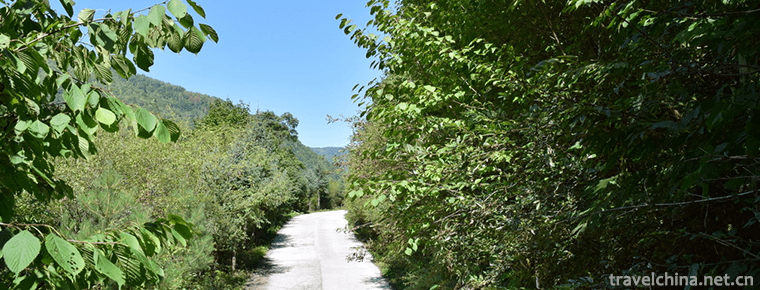
-
Nanshan Bamboo Sea Scenic Area
Tianmu Hunan Shanzhuhai Scenic Area is located in Liyang, Jiangsu Province, which is the junction of Jiangsu and Anhui Provinces. It is a national 5A scenic spot..
Views: 203 Time 2018-12-31 -
Anbang River National Wetland Park
Anbang River National Wetland Park is built on the basis of Anbang River Provincial Wetland Nature Reserve, which is located in Shuangyashan City, Heilongjiang Province.
Views: 130 Time 2019-01-02 -
Nanchong Xishan Scenic Area
Nanchong Xishan Scenic Spot, located in the west of Shunqing City, is a provincial scenic spot and a national 4A-level tourist attraction. It is the destination of "Three Kingdoms Cultural Explor.
Views: 203 Time 2019-02-25 -
Traditional fragrance making techniques
Fragrance, originated from herbs, not only fragrance overflowing nose, but also eliminating pollution, curing illness, recuperating body and mind, in a relaxed and happy heart, helping people calm dow.
Views: 125 Time 2019-04-21 -
Kazakh Dongbra Art
Winter Bula's strength and speed vary widely, especially for fast music. Dongbula is suitable for men and women. The basic method of playing is playing and picking. .
Views: 188 Time 2019-05-02 -
Jiaxing Kitchen Head Painting
Jiaxing stove painting is a form of Jiaxing folk art. Folk artists use painting pigments to draw patterns on the various parts of the kitchen wall, also known as "kitchen paintings" and &quo.
Views: 327 Time 2019-05-05 -
She nationality novel song
She nationality novel song originated from Bailukeng Village, Xinan Town, Xiapu County, Fujian Province. It was adapted and created by She nationality folk singers according to their national living c.
Views: 214 Time 2019-06-14 -
Wan Bang
Wan Bang is a rare local opera. It grows and distributes in Nanyang in southwestern Henan and its surrounding areas. In the early days, people called it Hao Bang, Lao Bang Zi, Nanyang Bang Zi, etc. Be.
Views: 148 Time 2019-06-25 -
Ulger
Uliger, which means "storytelling" in Mongolian, is commonly known as "Mongolian Shushu", "Mongolian Shushu" and "Mongolian Qinshu". It is a form of music art t.
Views: 145 Time 2019-06-29 -
Uzbek Ehilai and Yelai
Uzbek Ehilai and Yelai are mainly distributed in Kashgar, Shache, Yecheng and Yining, Ili Kazakh Autonomous Prefecture, Xinjiang Uygur Autonomous Region. Uzbek people have excellent music and dance cu.
Views: 120 Time 2019-06-29 -
National characteristics of Chinese embroidery
Nationality is the distinctive feature of Qinghai Folk Embroidery. In the long process of development, Qinghai embroidery has formed its own unique style. Due to the consistency of language, religious belief, festival etiquette, culture and entertainment,.
Views: 333 Time 2020-12-12 -
Meishan population
At the end of 2019, the total registered residence population was 3 million 422 thousand and 600, of which 1 million 194 thousand and 900 were urban population. At the end of the year, there were 2.995 million permanent residents, including 1.433 million urban.
Views: 333 Time 2020-12-18
